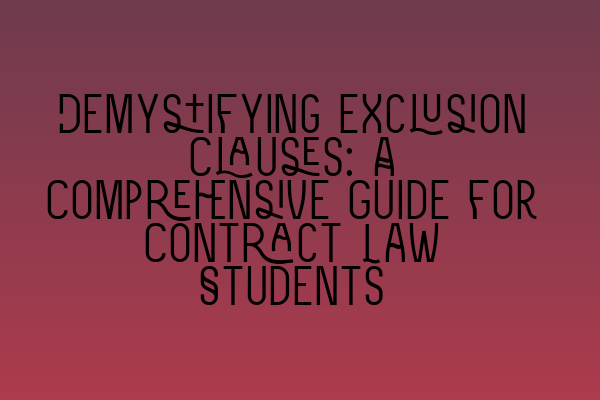Demystifying Exclusion Clauses: A Comprehensive Guide for Contract Law Students
Introduction
Welcome to SQE Contract Law! In this comprehensive guide, we will delve into the intricate world of exclusion clauses. As a contract law student, understanding exclusion clauses is paramount in becoming a proficient legal professional. By demystifying these clauses, we will equip you with the knowledge and expertise necessary to navigate this complex area of law. So, let’s waste no time and dive right in!
1. What are Exclusion Clauses?
Exclusion clauses are contractual provisions that restrict or exclude one party’s liability for certain types of loss or damage that may arise from the performance of a contract. These clauses are akin to protective shields for businesses, allowing them to limit their potential liability and offer their goods or services with confidence.
2. Types of Exclusion Clauses
(i) Limitation Clauses: Limitation clauses aim to cap the amount of liability a party may incur for any potential breach of contract. They usually specify a monetary limit or a defined period within which a claim for breach must be brought.
(ii) Exemption Clauses: Unlike limitation clauses, exemption clauses absolve one party from liability altogether for specific types of loss or damage. These clauses can be particularly contentious and often require careful analysis to ensure their validity.
3. Interpretation of Exclusion Clauses
To interpret an exclusion clause, the courts generally adopt a strict approach. Three key principles guide this interpretation:
(i) The contra proferentem rule: This rule states that any ambiguity or uncertainty in an exclusion clause should be interpreted against the party seeking to rely on it. In practice, this means that exclusion clauses are construed narrowly, ensuring that any limitations on liability are clear and unambiguous.
(ii) The reasonable notice requirement: For an exclusion clause to be enforceable, it must be brought to the attention of the party affected by it before or at the time the contract is formed. Adequate notice ensures that both parties are aware of the exclusions or limitations to liability.
(iii) Fundamental breach test: Exclusion clauses cannot exclude or limit liability for the consequences of a fundamental breach of contract. A fundamental breach goes to the core of the contract and is typically characterized by a repudiation of the entire agreement.
4. Key Cases and Legal Precedents
To truly grasp the complexities of exclusion clauses, it is essential to examine relevant legal cases. Some landmark cases provide valuable insights into how the courts interpret and apply exclusion clauses, such as:
(i) Olley v Marlborough Court Hotel (1949): In this case, it was held that an exclusion clause cannot be incorporated after the contract has been formed.
(ii) Photo Productions v Securicor (1980): The decision in this case demonstrates the importance of properly defining the type of loss or damage the exclusion clause seeks to exclude.
(iii) Canada Steamship Lines v The King (1952): This case introduced the concept of reasonable notice and emphasized the need to draw adequate attention to exclusion clauses to ensure their enforceability.
5. Factors Affecting Enforceability
Several factors can influence the enforceability of exclusion clauses, including:
(i) Unfair Contract Terms Act 1977 (UCTA): UCTA applies to both B2B and B2C contracts, aiming to regulate exclusion clauses and protect parties from oppressive terms.
(ii) Contra proferentem rule: As previously mentioned, any ambiguity in an exclusion clause is construed against the party seeking to rely on it. Clear and unambiguous clauses have a higher chance of being enforceable.
(iii) Industry standards and precedents: The courts often consider relevant industry customs and practices when interpreting exclusion clauses, emphasizing the importance of context and trade-specific expectations.
6. Drafting Effective Exclusion Clauses
To effectively draft exclusion clauses that withstand legal scrutiny, consider the following tips:
(i) Use clear and unambiguous language to ensure the clause’s meaning is easily understood.
(ii) Seek legal advice and conduct a thorough review of relevant precedents and cases.
(iii) Ensure adequate notice to the other party, bringing the exclusion clause to their attention before or at the time of contracting.
Conclusion
Demystifying exclusion clauses is essential for any contract law student, as it lays the foundation for understanding this complex area of law. By comprehensively exploring the various types, principles of interpretation, key cases, factors affecting enforceability, and tips for effective drafting, you are now equipped to navigate the intricate world of exclusion clauses confidently. Remember, always seek professional advice and stay updated with relevant legal developments to excel in your legal career.
